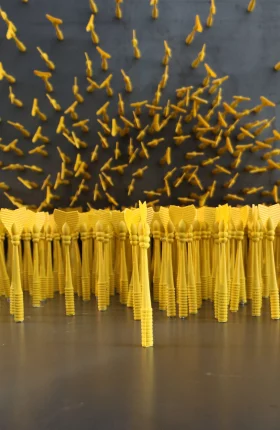Washington State’s economy is booming, producing great jobs that offer competitive salaries in world-class technology, aerospace, clean-energy, and biomedical companies. But a serious problem is lurking behind the boom: a leak in the pipeline for employees to fill the state’s most valuable jobs in science, technology, engineering, and math—collectively known as STEM.
In Great Jobs Within Our Reach , a 2013 joint report by The Boston Consulting Group and the Washington Roundtable, we calculated that, even after importing highly educated workers from out of state and abroad, Washington was missing out on an opportunity to fill as many as 25,000 high-skill jobs—a number that could double by 2017.
Now we estimate that only 9 out of 100 children born in Washington will ultimately end up as employees in a STEM-related field in the state—far fewer than the number of people needed to fill Washington jobs requiring STEM-related skills. (See “ The Facts About the STEM Employee Pipeline in Washington State .”) The situation is worse for low-income students, who are two to three times less academically prepared for the STEM workforce than their more affluent peers. Currently, only 40 percent of high school students in Washington graduate with competency in STEM topics. These skills are critical for the state’s citizens, regardless of whether they end up in STEM-related fields.
Creating more STEM jobs would not only boost Washington’s economy, it would also reduce poverty and unemployment, help all Washington families prosper, and create a better-prepared workforce. If Washington can match the practices of high-performing states, such as California and Massachusetts, it could double or triple the number of STEM jobs in the state as well as expand the participation of women and underrepresented minorities in the STEM workforce.
Right now, Washington State can fix the leaks in its STEM employee pipeline and be rewarded with an economic return equal to seven times its investment. The move could generate $4.5 billion in additional tax revenues and social-spending savings per year—a significant return on the $650 million investment needed. Even better, Washingtonians could take home $12.6 billion in additional salaries. What’s more, the state could lift nearly 100,000 people out of poverty and into the middle class.
STEM fields hold the jobs of tomorrow—and Washingtonians need to be ready to seize them.
The Situation in Washington
Washington sits at the top of
In Washington, STEM jobs pay nearly double the salaries of non-STEM positions and represent much of the economic future of the state. But Washington currently cannot meet the demand for STEM talent with qualified local employees.
Among a sample of states with significant technology sectors, Washington is the largest importer of technology degrees as a proportion of the population. The state ranks low in the production of computer science and engineering degrees relative to occupations in those fields. And it ranks last among high-tech-intensive states in the proportion of high school graduates who go directly to college.
Washington is not alone in facing serious challenges when it comes to filling jobs in high-demand STEM fields. Nationwide, there are
The STEM skills gap in Washington is widening because of a lack of preparedness and program capacity. The University of Washington, the state’s flagship, is at capacity and turns away more than half of the qualified students who wish to enroll: applications to the college of engineering and department of computer science and engineering, for example, have grown by more than 40 percent since the 2006-2007 academic year, while the number of students offered admission has remained relatively flat. Approximately 40 to 60 percent of students who were turned away had a grade point average of at least 3.25 (out of 4.0).
In short, the state creates a lot of high-impact jobs, but so far it has not created an efficient pathway for local students to get those jobs. Trying to fill great jobs with a leaky human-capital pipeline is like living in a boomtown without enough roads, electricity, or water.
What’s Holding Back Washington State
At many stages from before kindergarten and up to full-time employment, Washingtonians fall off the track for achieving the state’s greatest economic opportunities. A BCG analysis shows that Washington loses 91 out of 100 potential STEM employees in its workforce at some point “from cradle to career.”
We have found that students who go off the STEM track do so largely because of a lack of academic preparedness. In fact, we have identified five choke points in Washington’s educational system that are impeding the state’s ability to produce the volume of STEM graduates needed to address the job skills shortage. (See Exhibit 1.)
- Early Learning. We see signs of students at risk right from the start: one-third of children are not ready for kindergarten. (Even fewer will be ready for math in kindergarten.) Kids fall behind because of a lack of access to high-quality, affordable preschool and a lack of informal learning opportunities outside the classroom. While these students remain in the STEM employee pipeline, they enter the K-12 education system at a disadvantage.
- K-12 Education. Of every 100 children born in Washington, only 40 will graduate high school on track for a STEM-related career. The rest will fall out of the STEM employee pipeline because of poor overall academic performance, limited proficiency in science and math, or a lack of interest in STEM subjects.
- The Transition to College. Only 22 of every 100 kids will pursue STEM-related postsecondary education in Washington State. The major factors for this sharp decline include a lack of capacity in the state’s higher education system, students’ disinterest in STEM majors or in attending in-state universities, and students’ inability to afford postsecondary education.
- Postsecondary Education. Of those 22 STEM-major students who do enroll in college, only 13 will graduate from a two- or four-year college with a STEM-related degree. The rest will drop out, switch majors, or fail to finish on time.
- Career. Finally, only 9 of every 100 kids born in Washington will ultimately become employees in a STEM-related field in the state. Many others will take jobs outside the state or in fields unrelated to their major, despite high local demand.
Low-income students face particularly strong headwinds. Of these students, only 40 percent are ready for kindergarten at the traditional age, 25 percent are capable of completing STEM coursework in K-12, 12 percent are enrolled in STEM fields in postsecondary education, 6 percent graduate with STEM-related degrees, and 4 percent enter STEM jobs. We see the potential to at least triple STEM graduation rates among these students by raising academic performance to levels closer to those of wealthier students. Targeted interventions would have the dual effects of reducing the STEM jobs gap in Washington State and helping to break the cycle of poverty for low-income students in the state.
If Washington invests in the STEM employee pipeline today, however, it could change the lives of thousands of students, as well as fuel economic growth. If Washington could match the performance of the best-performing states in the U.S.—such as Massachusetts for early learning and K-12, and California for higher education—the number of Washingtonians who pursue STEM careers in the state could double or even triple.
How to Prepare Washingtonians for Tomorrow’s Jobs
Now is the time for investments to strengthen the STEM employee pipeline in Washington State. The Washington Supreme Court has mandated an increase in spending on basic education of about $4 billion, some of which could be targeted at STEM education. In addition, the business and nonprofit community has shown its strong commitment to addressing the innovation skills gap.
There is no silver-bullet solution, however. Washington will need to invest throughout the STEM employee pipeline, pursuing strategies such as the following to move the needle.
- Early Learning. The state must invest in early-learning opportunities for every student in Washington State and emphasize numeracy development in addition to a traditional literacy focus. Thrive by Five Washington, a public-private partnership focused on early learning, offers a promising approach with programs to increase parental engagement, informal teaching and curriculum support, and funding for STEM programs. Altogether, these efforts are reaching tens of thousands of students, many in low-income and rural communities.
- K-12 Education. Washington must invest in boosting student interest and success in STEM subjects, as well as in recruiting, training, and retaining world-class STEM teachers and arming them with top-quality curriculum and other instructional materials. For example, Washington STEM, a nonprofit dedicated to advancing STEM education in the state, has been working to develop cutting-edge models for teachers’ professional development and to make Washington the first state to provide computer science education in every K-12 school.
- The Transition to College. Stakeholders must increase access to college by boosting the capacity to grant STEM degrees at state universities and colleges in Washington and by promoting equal opportunity through scholarships. Washington needs to double its STEM capacity in higher education while expanding scholarship programs such as the Washington State Opportunity Scholarship, which helps low- and middle-income state residents earn a bachelor’s degree in high-demand STEM fields.
- Postsecondary Education. Washington must invest in retaining at-risk students. The Mathematics Engineering Science Achievement Community College Program (MCCP) exemplifies success in this field. The MCCP’s at-risk students advance through postsecondary education at a rate of approximately 75 percent per year, much higher than the average rate of about 45 percent for students who are not in the MCCP.
- Career. The state must invest in career coaching and employer outreach so that 100 percent of interested graduates can land a great STEM job in Washington. Businesses are starting to step up by partnering with schools to promote STEM career awareness and inspiration and by changing workplace cultures and practices to ensure that companies are friendly to women and other populations that are currently underrepresented in STEM fields. All of these efforts need to create the right incentives and systems for success.
The Impact of Developing More Washingtonian STEM Employees
Developing more STEM employees in these ways would have an enormous impact on Washington State. First, landing a STEM job dramatically improves the lives of employees and their families. Paying nearly double the salaries of non-STEM positions, STEM jobs can be a pathway to the middle class for thousands of families.
Furthermore, creating STEM jobs in turn generates other jobs in the state. Every job created in a STEM industry—such as software development, manufacturing, health care, and engineering—generates an average of two additional indirect jobs. If the state makes the structural changes outlined above, Washingtonians could fill an additional 8,000 STEM jobs and an additional 16,000 indirect jobs could be created per year. These steps could reduce unemployment from the current rate of more than 6 percent to approximately 5 percent. That’s equivalent to 18 percent fewer unemployed people.
These improvements in the state’s economic development could also improve social equity in Washington. Today, only one in four STEM employees is female and only one in five is black or Hispanic. Efforts to target female, black, and Hispanic STEM employees could potentially increase their presence in the workforce by about 30 percent.
All told, the result would be a total public return on investment of up to seven times—meaning that for every $1 spent on STEM education, $7 of taxes and social-spending savings would be gained. For example, the roughly $650 million investment that we recommend would return $4.5 billion per year, as well as an increase of $12.6 billion in salaries per year.
Over the next 15 years, nearly 100,000 Washingtonians from low-income brackets and underrepresented minority groups would be given new economic opportunities, shaving more than a full percentage point off the poverty rate. (See Exhibit 2.)
Unless much more is done to address the STEM employee pipeline, the costs of failing to address the skills gap will only increase in the years ahead. Students will continue to leave Washington State in droves to
pursue higher education
elsewhere. The war for out-of-state and international talent will intensify, and Washingtonians will not prevail. Companies will locate more and more jobs outside the state. Washington will miss a golden opportunity to shepherd its residents—particularly women, underrepresented minorities, and those with low incomes—into the high-paying STEM jobs of the future.
The payoff is hard to beat. Not many alternatives offer a sevenfold return on investment for government, a massive increase in opportunity for nearly 100,000 Washington natives, and a boost to the long-term competitiveness of the region.
Washington must take immediate steps to prepare local students to seize the great jobs in its backyard. The rewards are simply too great.
Acknowledgments
The authors would like to thank the following individuals for their generosity in sharing their insights and for allowing us to learn from them: Jeff Knudsen and Vickie Rekow of the College Success Foundation; Jane Broom Davidson of Microsoft; Sam Whiting of Thrive by Five Washington; Patrick D’Amelio, Alex Johnston, and Caroline King of Washington STEM; and Theresa Britschgi, Megan Nelson, and Naria K. Santa Lucia of the Washington State Opportunity Scholarship.
The authors also thank Mickey Butts for his assistance in writing the report and producing the online interactive, and Glen Gunawan and Whitney Haring-Smith, who helped with underlying research and with the report’s writing. Finally, the authors wish to thank Katherine Andrews, Gary Callahan, Dan Coyne, Jon Desrats, Lilith Fondulas, Federico Fregni, Kim Friedman, Abby Garland, Melanie Jarzyniecki, and Sara Strassenreiter for their contributions to the report’s editing, design, and production.








